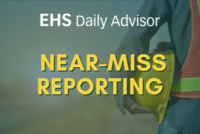In this installment of EHSDA Shorts, Monica Patel, Product Manager, KPA, Dustin Baxter, Account Executive, KPA, and Kat McConnell, host of KPA’s “The Safety Meeting Podcast,” talk about how EHS technology can address modern safety challenges.
In this installment of EHSDA Shorts, Adele L. Abrams, Esq., CMSP, Firm President, Law Office of Adele L. Abrams P.C., talks about the OSHA mandatory reporting requirements.
On episode 191 of EHS On Tap, John Ho, co-chair of the OSHA Workplace Safety Practice at Cozen O’Connor, talks about OSHA’s new injury reporting rule.
When you investigate safety and health incidents, do you also investigate near misses? Here’s what you need to know about near-miss reporting and how it can be used to improve safety systems, hazard control, risk reduction, and to educate employees.
Back to Basics is a weekly feature that highlights important but possibly overlooked information that any EHS professional should know. This week, we examine near-miss reporting. Incident investigation often focuses on finding the causes of adverse safety events, but it’s also a good idea to investigate near-miss incidents (also known as “close calls”). Near misses […]
A little-known rule under the Clean Air Act (CAA) known as the “exceptional events rule” allows local regulators to exclude certain high-pollution days from their National Ambient Air Quality Standards (NAAQS) data reporting. “Exceptional Events are unusual or naturally occurring events that can affect air quality but are not reasonably controllable using techniques that tribal, […]
In October 2023, the EPA released 2022 greenhouse gas (GHG) data collected under the EPA’s Greenhouse Gas Reporting Program (GHGRP). For 2022, the report reveals emissions from large industrial sources were approximately 1% lower than in 2021. Cumulative data collected also shows an overall long-term decreasing trend in industry GHG emissions since 2011, which is […]
Private sector employers reported 2.8 million nonfatal workplace injuries and illnesses in 2022—up 7.5% from 2021, the Bureau of Labor Statistics (BLS) reported November 8. The increase was driven by the rise in both injuries, up 4.5% to 2.3 million cases, and illnesses, up 26.1% to 460,700 cases. The increase in the number of illnesses […]
After several deadline extensions, the EPA released its final per- and polyfluoroalkyl substances (PFAS) data reporting rule in late September 2023. The rule is expected to provide the “EPA, its partners, and the public with the largest-ever dataset of per- and polyfluoroalkyl substances (PFAS) manufactured and used in the United States,” according to an Agency […]
In October 2023, California Governor Gavin Newsom signed two landmark laws that will require companies with more than $1 billion in annual revenues operating in California to disclose both direct and indirect emissions resulting from their operations and report on climate-related financial risks. SB 253 One of the new laws, SB 253, has been characterized […]










